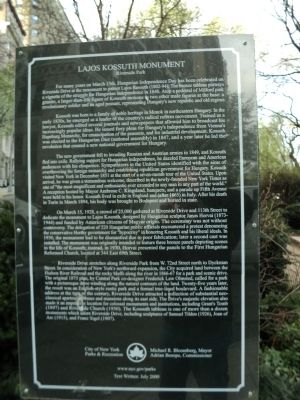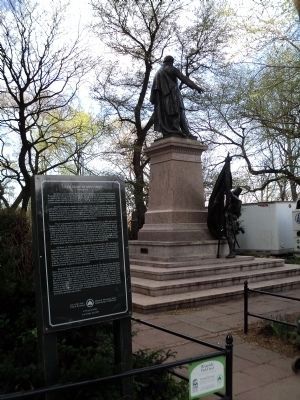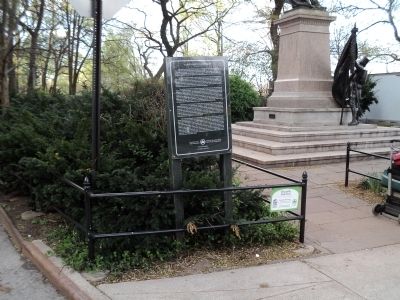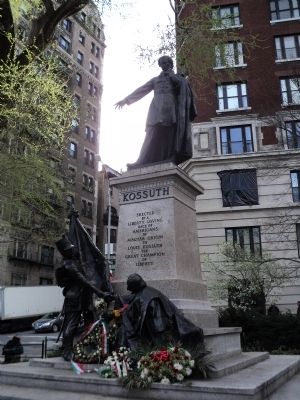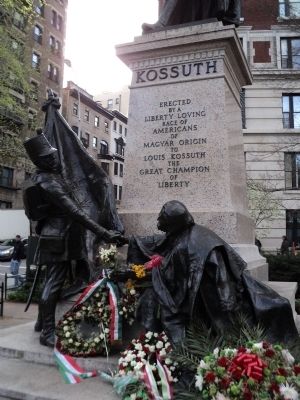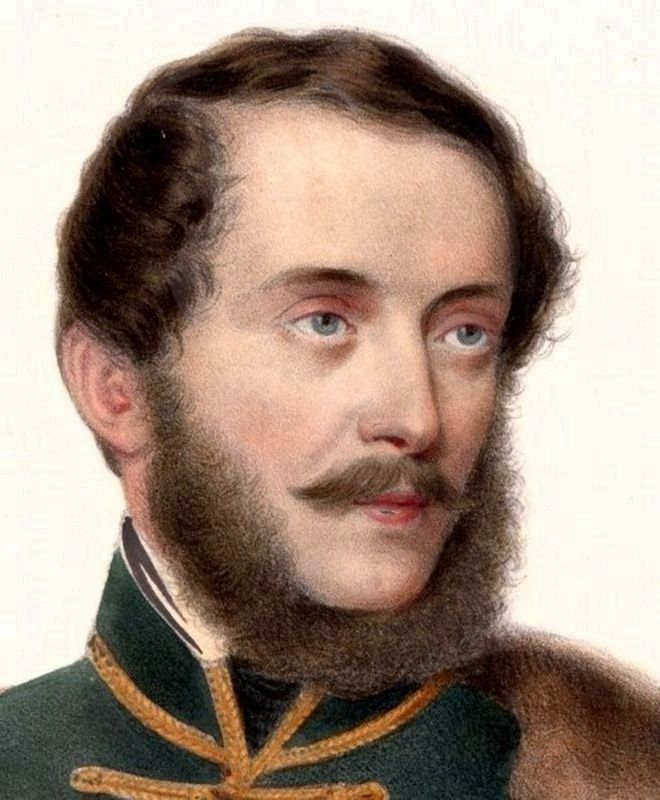Morningside Heights in Manhattan in New York County, New York — The American Northeast (Mid-Atlantic)
Lajos Kossuth Monument
Riverside Park
For many years on March 15th, Hungarian Independence Day has been celebrated on Riverside Drive at the monument to patriot Lajos Kossuth (1802-94). The bronze tableau portrays a vignette of the struggle for Hungarian independence in 1848. Atop a pedestal of Milford pink granite, a larger-than-life figure of Kossuth motions to two other male figures at the base: a revolutionary soldier and an aged peasant, representing Hungary’s new republic and old regime.
Kossuth was born to a family of noble heritage in Monok in northeastern Hungary. In the early 1830s, he emerged as a leader of the country’s radical reform movement. Trained as a lawyer, Kossuth edited several journals and newspapers that allowed him to broadcast his increasingly popular ideas. He issued fiery pleas for Hungary’s independence from Vienna’s Hapsburg Monarchy, for emancipation of the peasants, and for industrial development. Kossuth was elected to the Hungarian Diet (national assembly) in 1847, and a year later he led the revolution that created a new national government for Hungary.
The new government fell to invading Russian and Austrian armies in 1849, and Kossuth fled into exile. Rallying support for Hungarian independence, he dazzled European and American audiences with his eloquence. Sympathizers in the United States identified with the aims of overthrowing the foreign monarchy and establishing republican government for Hungary. Kossuth visited New York in December 1851 at the start of a seven-month tour of the United States. Upon arrival, he was given a tremendous welcome, described in the newly-founded New York Times as one of “the most magnificent and enthusiastic ever extended to any man in any part of the world.” A reception hosted by Mayor Ambrose C. Kingsland, banquets, and a parade up Fifth Avenue were held in his honor. Kossuth lived in exile in England and (after 1865) in Italy. After his death in Turin in March 1894, his body was brought to Budapest and buried in state.
On March 15, 1928, a crowd of 25,000 gathered at Riverside Drive and 113th Street to dedicate the monument to Lajos Kossuth, designed by Hungarian sculptor Janos Horvai (1873-1944) and funded by American citizens of Magyar origin. The ceremony was not without controversy. The delegation of 520 Hungarian public officials encountered a protest denouncing the conservative Horthy government for “hypocrisy” in honoring Kossuth and his liberal ideals. In 1930, the monument had to be dismantled due to poor fabrication; later a second cast was installed. The monument was originally intended to feature three bronze panels depicting scenes in the life of Kossuth; instead, in 1930, Horvai presented
the panels to the First Hungarian Reformed Church, located at 344 East 69th Street.
Riverside Drive stretches along Riverside Park from W. 72nd Street north to Dyckman Street. In consideration of New York’s northward expansion, the City acquired land between the Hudson River Railroad and the rocky bluffs along the river in 1866-67 for a park and scenic drive. The original 1875 plan, by Central Park co-designer Frederick Law Olmsted, called for a park with a picturesque drive winding along the natural contours of the land. Twenty-five years later, the result was an English-style rustic park and a formal tree-lined boulevard. A fashionable address at the turn of the century, Riverside Drive attracted a collection of substantial neoclassical apartment houses and mansions along its east side. The Drive’s majestic elevation also made it an impressive location for colossal monuments and institutions, including Grant’s Tomb (1897) and Riverside Church (1930). The Kossuth tableau is one of more than a dozen monuments which adorn Riverside Drive, including sculptures of Samuel Tilden (1926), Joan of Arc (1915), and Franz Sigel (1907).
City of New York Parks & Recreation
Michael R. Bloomberg, Mayor
Adrian Benepe, Commissioner
Text Written: July 2000
Erected 2000 by City of New York Parks & Recreation.
Topics. This historical marker and monument is listed in these topic lists: Arts, Letters, Music • Patriots & Patriotism. A significant historical month for this entry is March 1835.
Location. 40° 48.408′ N, 73° 58.035′ W. Marker is in Manhattan, New York, in New York County. It is in Morningside Heights. Marker is at the intersection of Riverside Drive and W 113th Street, on the right when traveling north on Riverside Drive. Touch for map. Marker is in this post office area: New York NY 10025, United States of America. Touch for directions.
Other nearby markers. At least 8 other markers are within walking distance of this marker. Kossuth (a few steps from this marker); Morningside Heights Historic District (within shouting distance of this marker); Samuel J. Tilden (within shouting distance of this marker); Samuel Tilden Statue (within shouting distance of this marker); Cecil B. DeMille (about 400 feet away, measured in a direct line); John Dewey (about 700 feet away); Harlan Fiske Stone (approx. 0.2 miles away); Woman's Health Protective Association Fountain (approx. 0.2 miles away). Touch for a list and map of all markers in Manhattan.
Also see . . .
1. The 1928 Kossuth Monument -- Riverside Drive at 113th Street. "Daytonian in Manhattan" entry. (Submitted on April 11, 2020, by Larry Gertner of New York, New York.)
2. Lajos Kossuth. Wikipedia biography. (Submitted on April 11, 2020, by Larry Gertner of New York, New York.)
Credits. This page was last revised on January 31, 2023. It was originally submitted on March 30, 2012, by Bill Coughlin of Woodland Park, New Jersey. This page has been viewed 550 times since then and 30 times this year. Photos: 1, 2, 3, 4, 5. submitted on March 30, 2012, by Bill Coughlin of Woodland Park, New Jersey. 6. submitted on April 11, 2020, by Larry Gertner of New York, New York.
